NSKK M36 Chained Service Dagger by E. & F. Hörster
CATEGORY: Version
SKU: 53.GOR.04.02.002.000
Estimated market value:
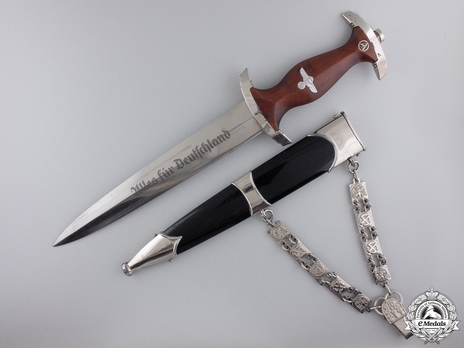
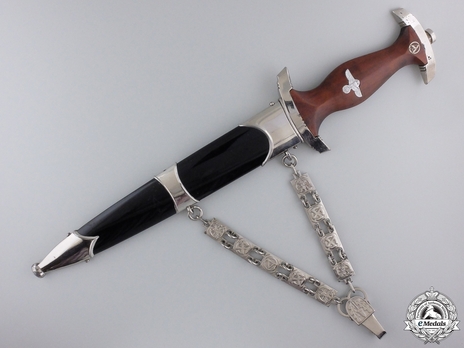
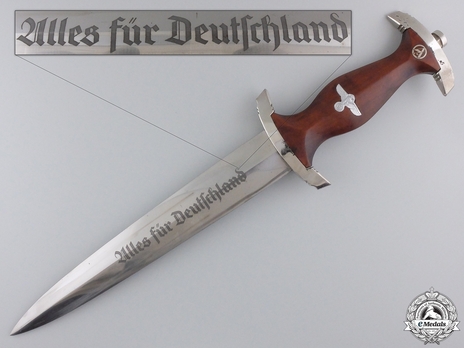
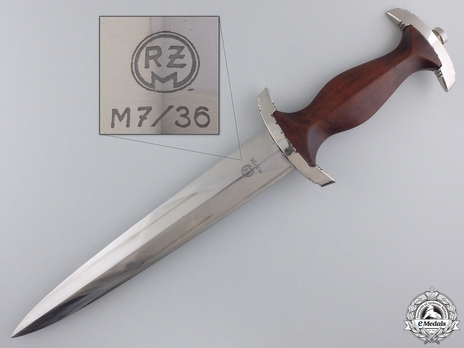
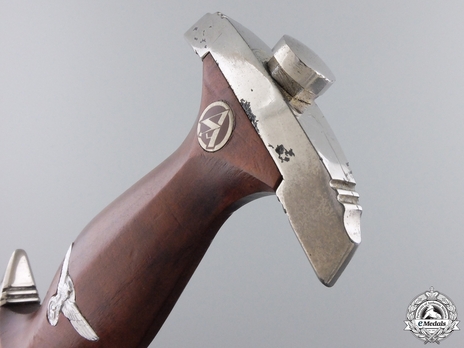
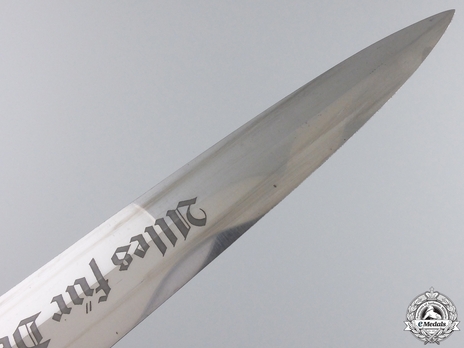
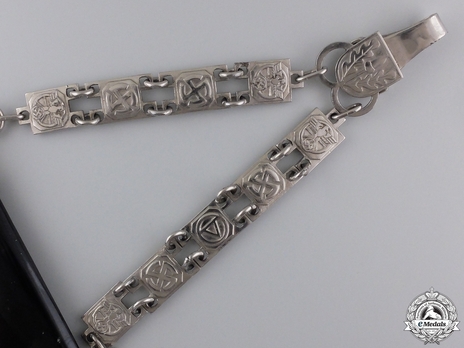
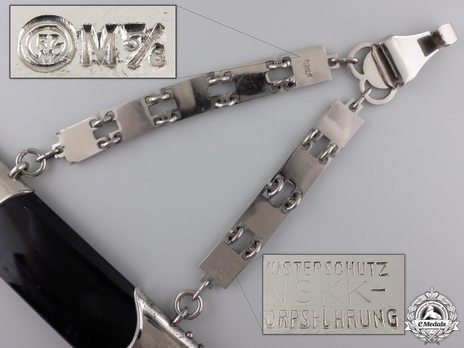
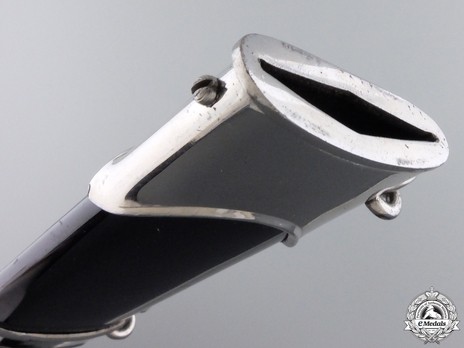
Estimated market value:
A Chained RZM NSKK Dagger by E. & F. Hörster, Solingen - Measuring 371 mm in length with the scabbard on, this NSKK dagger is engraved "Alles für Deutschland" on the blade, exhibiting beautiful crossgraining, with the usual in and out runner marks, very sharp edges and a very sharp tip. It is marked with the RZM (Reichszeugmeisterei) insignia and maker marked "M7/36" (E. & F. Hörster, Solingen) on the reverse ricasso, exhibiting scattered surface wear, measuring 222 mm in length and rating near extremely fine. Nickel plated fittings on both crossguards, along with the pommel, tight nut on the pommel, both crossguards exhibit scattered chipping in the plating where they butt the wooden handle and light contact overall. Dark reddish brown wooden handle exhibits very light contact and is without chipping, embedded finely-detailed aluminum eagle rates near extremely fine, as does the SA insignia, its brown enamels and silvering intact, the dagger measuring 350 mm in length. The scabbard fittings with light contact overall, contact marks and scratches evident on the black painted body from active use. Ball finial exhibits contact marks and pitting, the locket and chape held firmly in place via two screws each. Rings attached to the locket and central band, the chain attached being the typical factory type, the upper chain composed of four links, the lower chain with five links, acorn and oak leaves insignia on the clip, the clip itself non-functional, having lost its spring-loaded capability. The chain is marked with the RZM insignia and maker marked "M5/8" (F.W. Assmann & Söhne, Lüdenscheid) on the reverse of the lower link and marked "NSKK MUSTERSCHUTZ KORPSFÜHRUNG" on the reverse of the upper link, the scabbard measuring 245 mm in length. Near extremely fine.
The NSKK (Nationalsozialistisches Kraftfahr-Korps = National Socialist Motor Corps) was a paramilitary organisation affiliated with the NSDAP, specialising in anything related to the driving of motorised vehicles. NSDAP officials recognised the need for access to cars and trucks for both transportation and propaganda purposes as early as 1922, and certain steps were taken to ensure this need was met. However, it took until April of 1930 for a specialised motor organisation to be officially founded. This organisation was named NSAK (Nationalsozialistisches Automobil-Korps = National Socialist Automobile Corps), but was renamed to NSKK less than 13 months later.
Initially, the NSAK/NSKK was under the control of the SA and existed next to its parent organisation’s own driving-related sub-organisation, the Motor-SA. This changed after the “Night of the Long Knives”, in which many SA leaders were purged and the organisation was substantially disempowered. After July of 1934, the NSKK became an independent organisation whose leader, NSKK-Korpsführer Adolf Hühnlein, answered directly to Adolf Hitler.
The main tasks of the NSKK were to provide transportation for all organisations of the Third Reich, to train and instruct boys and men (and a number of women) in mechanics and driving, and to assist police in regulating traffic. During the mid 1930s, the organisation also provided roadside assistance.
With the onset of the war, the NSKK’s tasks underwent certain changes. Instructing both civilians and soldiers in the driving and maintenance of armored vehicles became a higher priority. The NSKK also began working closely with other organisations, for example Organisation Todt (OT), by providing transportation of workers and supplies for the colossal building project that was the fortification of Germany’s Western border, the Siegfried Line (or Westwall). During the war, the NSKK provided much of the transportation needs for the German Army and the Luftwaffe, including the transport of troops, weapons and ammunition, and building materials, for example for the construction of air bases in the newly conquered territories in Eastern Europe after the attack on Soviet Russia in the summer of 1941.
Parts of the NSKK would come under the control of architect Albert Speer who took over OT after the death of Fritz Todt in 1942, leading to the creation of Transport Brigade Speer (later Transport Corps Speer), which would eventually completely sever its ties to the NSKK.
In 1936, NSKK leader Adolf Hühnlein introduced the M36 Chained Dagger for NSKK personnel of Officer rank (Sturmführer and above). The design of the dagger is essentially the same as the 1933 Service Dagger, except for the double-chain hanger that is attached to the scabbard of the new model. The chain design was inspired by that of the SS Chain Dagger.
The chain is composed of square-shaped links that on the obverse are embossed with either the NSKK emblem, a swastika sun wheel, or a “Thurs” rune. The upper chain may be composed of either three or four chain links, while the lower chain is composed of five chain links. The two chains are joined together with a snap fitting that is embossed with two oak leaves and an acorn. One of the top chain links is stamped with an RZM control mark on the reverse and the other is stamped with the authorization mark “MUSTERSCHUTZ NSKK-KORPSFÜHRUNG” (Copyright NSKK Corps Leadership) on the reverse. The fittings on the scabbard are unadorned and the dagger chains attach to the upper and central ramp.
The dagger blade was initially produced out of solid nickel-silver, but was later manufactured out of pressure-molded zinc or iron and plated with chrome. The obverse of the blade is etched with the motto “Alles für Deutschland” (Everything for Germany) and the reverse features a manufacturer’s logo or an RZM control mark. The scabbard may be painted black or have an anodised finish.
When worn with the service uniform, the dagger was suspended vertically from the left hip or from the wearer’s belt. When it was worn with the walking-out dress uniform, the dagger was worn without a belt and it was attached to an undercarry belt through a slit under the left pocket flap.

Comments
Sign in to comment and reply.


Scroll Top